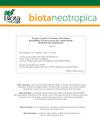Insect galls on Asteraceae in Brazil: richness, geographic distribution, associated fauna, endemism and economic importance
IF 1.2
4区 环境科学与生态学
Q3 BIODIVERSITY CONSERVATION
引用次数: 1
Abstract
Abstract: An overview of insect galls on Asteraceae in Brazil is presented. We used the Web of Science database to find publications about insect galls from 1988 to 2020. We analyzed 88 publications and collected data from 51 of those. A total of 487 gall morphotypes were counted on 157 plant species of 42 genera. This value singled out Asteraceae as the richest plant family in number of gall morphotypes in Brazil. Most morphotypes were recorded in the Atlantic Forest (41%) and Cerrado (30.5%), the most surveyed biomes in Brazil. Baccharis L. supported the greatest gall richness (43.9%), which could be explained by the hypotheses of geographic area and taxon size. Baccharis concinna G.M. Barroso, B. dracunculifolia DC. and B. platypoda DC. were indicated as superhost species. Most galls were induced on stems (52.2%), a pattern known in Asteraceae for gall-inducing Tephritidae and Chloropidae, and extended in the present study to Cecidomyiidae. Most galls were fusiform (42.5%), which can be related to the highest number of gall on stems. Cecidomyiidae (Diptera) were the most frequent inducers, as observed worldwide. The presence of other dwellers - parasitoids, cecidophages, kleptoparasites, and successors - were reported in 8.8% of the gall morphotypes, being parasitoids the most frequent, as found in other Brazilian publications. Most host plants (58%) are endemic to Brazil, 14% are useful and few are vulnerable or endangered (six and four species, respectively). Due to the high host specificity, the gall-inducers associated with these plants can also be considered either endemic, important, vulnerable and/or endangered, respectively.巴西菊科昆虫瘿:丰富度、地理分布、伴生动物群、特有性和经济重要性
摘要:综述了巴西菊科昆虫瘿的研究概况。我们使用Web of Science数据库查找1988年至2020年有关虫瘿的出版物。我们分析了88份出版物,并收集了其中51份的数据。共有42属157种植物的487种胆形态。在巴西,菊科是胆形态最丰富的植物科。大西洋森林(41%)和塞拉多(30.5%)是巴西调查最多的生物群系。Baccharis L.的胆丰富度最高(43.9%),这可以用地理面积和分类单元大小的假设来解释。Baccharis concinna g.m.b arroso, B. dracunculliolia DC。B.鸭嘴兽;被标记为超级寄主种。大多数瘿发生在茎上(52.2%),这一模式在菊科中见于织蛾科和绿蛾科,本研究将该模式推广到绢瘿科。大部分瘿呈梭状(42.5%),这可能与茎上瘿数最多有关。在世界范围内,双翅目蠓科是最常见的诱导剂。据巴西其他出版物报道,在8.8%的瘿形态中存在其他居住者——拟寄生虫、食虫虫、偷窃寄生虫和继承者,其中拟寄生虫最为常见。大多数寄主植物(58%)是巴西特有的,14%是有用的,少数是脆弱或濒危的(分别为6种和4种)。由于具有较高的寄主特异性,与这些植物相关的胆管诱导剂也可以分别被认为是地方性的、重要的、脆弱的和/或濒危的。
本文章由计算机程序翻译,如有差异,请以英文原文为准。
求助全文
约1分钟内获得全文
求助全文
来源期刊

Biota Neotropica
BIODIVERSITY CONSERVATION-
CiteScore
2.90
自引率
16.70%
发文量
0
审稿时长
4-8 weeks
期刊介绍:
BIOTA NEOTROPICA is an electronic, peer-reviewed journal edited by the Program BIOTA/FAPESP: The Virtual Institute of Biodiversity. This journal"s aim is to disseminate the results of original research work, associated or not to the program, concerned with characterization, conservation and sustainable use of biodiversity within the Neotropical region.
Manuscripts are considered on the understanding that their content has not appeared, or will not be submitted, elsewhere in substantially the same form, because once published their copyrights are transferred to BIOTA NEOTROPICA as established in the Copyright Transfer Agreement signed by the author(s).
 求助内容:
求助内容: 应助结果提醒方式:
应助结果提醒方式:


